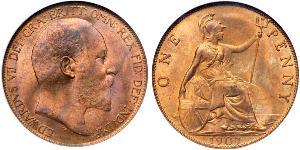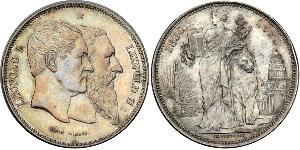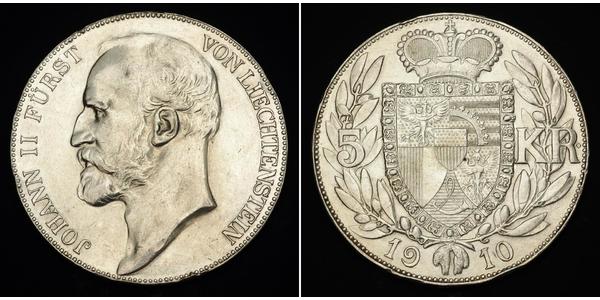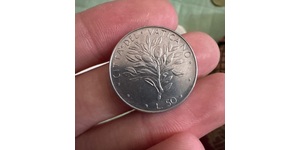(Vendida por $164.0)
1910, Liechtenstein, Prince Johann II "the Good". Silver 5 Kronen Coin. Polished!
Mint Year: 1910 Mintage: 10,000 pcs. Denomination: 5 Kronen Mint Place: Vienna (Austria) Condition: Polished surfaces, a few edge-hits, otherwise XF! Reference: Davenport 216, KM-Y#4. R! Material: Silver (.900) Diameter: 36mm Weight: 24gm
Obverse: Head of Prince Johann II of Liechtenstein left. Legend: JOHANN II FURST VON LIECHTENSTEIN
Reverse: Crowned shield of Liechtenstein, within Order of the Golden Fleece chain and olive-wreath. Legend: 5 - KR / 19 - 10
Edge Legend: FEST * UND * KLAR * ("Strong and clear!")
Johann II, Prince of Liechtenstein, born Johann Maria Franz Placidus (Eisgrub, Moravia, 5 October 1840 – Valtice, 11 February 1929), aka Johann II der Gute or Johann II the Good, was the Prince of Liechtenstein between 1858 and 1929. His reign of 70 years, 3 months is the second longest in European royal history after that of Louis XIV of France.
Johann II was the son of Aloys II, Prince of Liechtenstein and Countess Franziska Kinsky. He ascended to the throne shortly after his 18th birthday, and as such his reign is the longest precisely documented tenure of any monarch since antiquity in which a regent was never employed.
In 1862, Johann II issued Liechtenstein's first constitution. Later, after Liechtenstein left the German confederation in 1866 and World War I, Johann II granted a new constitution in 1921. It granted considerable political rights to common Liechtensteiners, the latter making the principality a constitutional monarchy. This constitution survives today but with revisions, most notably in 2003.
Liechtenstein left the German Confederation in 1866. Not long after, the army of Liechtenstein was abolished as it was regarded as an unnecessary expense.
Johann II somewhat cooled relations with Liechtenstein's traditional ally, Austria-Hungary and its successor states, to forge closer relations with Switzerland, particularly after World War I. Liechtenstein was neutral during World War I but the war did break Liechtenstein's alliance with Austria-Hungary and led it to go into a customs union with Switzerland. Late in Johann's reign, in 1924 the Swiss franc became Liechtenstein's official currency.
Johann II added much to the Liechtenstein Princely Collections. Although considered a prominent patron of the arts and sciences during his long reign, Johann II was also considered to be rather unsociable and did not participate in social events. He never married or had any children, like several other members of his family.
Between 1905 - 1920, Schloss Vaduz was renovated and expanded. Prince Johann II did not live in the castle or even Liechtenstein, though his successors would eventually move there in 1938. Schloss Vaduz would be their home.
He was the 987th Knight of the Order of the Golden Fleece in Austria. Upon his death in 1929, Johann II was succeeded by his brother Franz I.
Only 1$ shipping for each additional coin purchased!

5 Krone Liechtenstein Plata Johann II, P ...
grupo tiene 22 monedas / 21 precios
Add coin to this group

2 Krone Liechtenstein Plata Johann II, P ...
grupo tiene 13 monedas / 12 precios
Add coin to this group

5 Perper Montenegro Plata Nicolás I de ...
grupo tiene 15 monedas / 14 precios
Add coin to this group

2 Thaler Ducado de Brunswick (1815 - 191 ...
grupo tiene 18 monedas / 18 precios
Add coin to this group

1 Penny Reino Unido de Gran Bretaña e Ir ...
grupo tiene 24 monedas / 23 precios
Add coin to this group

2 Thaler Hesse-Darmstadt (1806 - 1918) P ...
grupo tiene 57 monedas / 56 precios
Add coin to this group

2 Thaler Reino de Prusia (1701-1918) Pla ...
grupo tiene 10 monedas / 10 precios
Add coin to this group

5 Franc Bélgica Plata Leopoldo I de Bélg ...
grupo tiene 9 monedas / 9 precios
Add coin to this group
27 coins were uploaded from 2025-05-28 to 2025-06-04
Una de ellas es:
44 coins were grouped from 2025-05-28 to 2025-06-04
Una de ellas es:
1 Rublo Imperio ruso (1720-1917) Plata
grupo tiene 12 monedas / 12 precios
⇑









-300-150-72sKbzbis7EAAAFPBUQ1Mk0C.jpg)
-300-150-9UEKbzbiU5UAAAFQcX3krksT.jpg)





